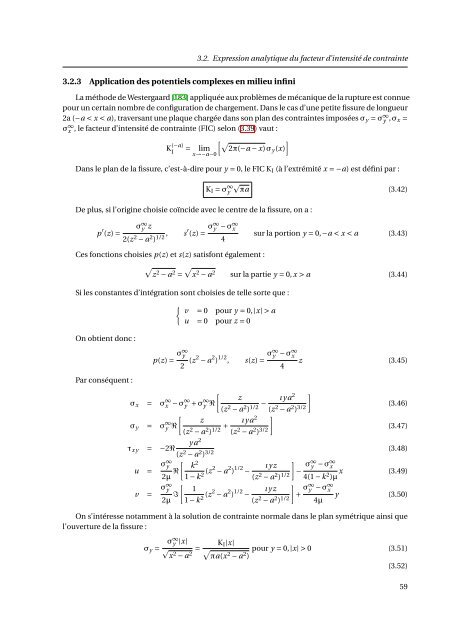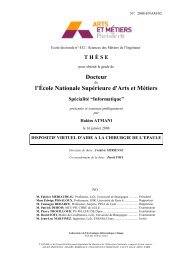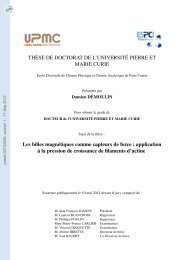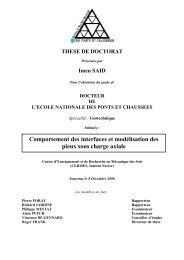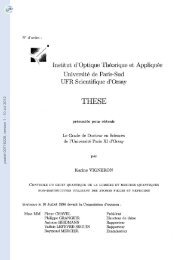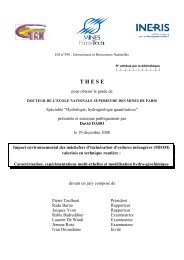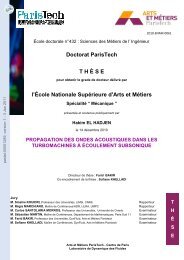Etude numérique de la fissuration d'un milieu viscoélastique - Pastel
Etude numérique de la fissuration d'un milieu viscoélastique - Pastel
Etude numérique de la fissuration d'un milieu viscoélastique - Pastel
Create successful ePaper yourself
Turn your PDF publications into a flip-book with our unique Google optimized e-Paper software.
3.2.3 Application <strong>de</strong>s potentiels complexes en <strong>milieu</strong> infini<br />
3.2. Expression analytique du facteur d’intensité <strong>de</strong> contrainte<br />
La métho<strong>de</strong> <strong>de</strong> Westergaard [183] appliquée aux problèmes <strong>de</strong> mécanique <strong>de</strong> <strong>la</strong> rupture est connue<br />
pour un certain nombre <strong>de</strong> configuration <strong>de</strong> chargement. Dans le cas d’une petite fissure <strong>de</strong> longueur<br />
2a (−a < x < a), traversant une p<strong>la</strong>que chargée dans son p<strong>la</strong>n <strong>de</strong>s contraintes imposées σy = σ∞ y ,σx =<br />
σ∞ x , le facteur d’intensité <strong>de</strong> contrainte (FIC) selon (3.39) vaut :<br />
K (−a)<br />
<br />
= lim 2π(−a − x)σy (x)<br />
I x→−a−0<br />
Dans le p<strong>la</strong>n <strong>de</strong> <strong>la</strong> fissure, c’est-à-dire pour y = 0, le FIC KI (à l’extrémité x = −a) est défini par :<br />
KI = σ ∞ y<br />
De plus, si l’origine choisie coïnci<strong>de</strong> avec le centre <strong>de</strong> <strong>la</strong> fissure, on a :<br />
p ′ (z) =<br />
σ∞ y z<br />
2(z2 − a2 ) 1/2 , s′ (z) = σ∞y − σ∞x 4<br />
Ces fonctions choisies p(z) et s(z) satisfont également :<br />
πa (3.42)<br />
sur <strong>la</strong> portion y = 0,−a < x < a (3.43)<br />
<br />
z2 − a2 <br />
= x2 − a2 sur <strong>la</strong> partie y = 0, x > a (3.44)<br />
Si les constantes d’intégration sont choisies <strong>de</strong> telle sorte que :<br />
On obtient donc :<br />
Par conséquent :<br />
v = 0 pour y = 0,|x| > a<br />
u = 0 pour z = 0<br />
p(z) = σ∞y 2 (z2 − a 2 ) 1/2 , s(z) = σ∞y − σ∞x 4<br />
z (3.45)<br />
σx = σ ∞ x − σ∞y + σ∞y ℜ<br />
<br />
z<br />
(z2 − a2 ı y a<br />
−<br />
) 1/2 2<br />
(z2 − a2 ) 3/2<br />
σy =<br />
<br />
σ<br />
(3.46)<br />
∞ y ℜ<br />
<br />
z<br />
(z2 − a2 ı y a<br />
+<br />
) 1/2 2<br />
(z2 − a2 ) 3/2<br />
<br />
(3.47)<br />
τx y =<br />
y a<br />
−2ℜ<br />
2<br />
(z2 − a2 ) 3/2<br />
u =<br />
(3.48)<br />
σ∞y 2µ ℜ<br />
2 k<br />
1 − k2 (z2 − a 2 ) 1/2 ı y z<br />
−<br />
(z2 − a2 ) 1/2<br />
<br />
− σ∞y − σ∞x 4(1 − k2 v =<br />
x<br />
)µ<br />
(3.49)<br />
σ∞y 2µ ℑ<br />
<br />
1<br />
1 − k2 (z2 − a 2 ) 1/2 ı y z<br />
−<br />
(z2 − a2 ) 1/2<br />
<br />
+ σ∞y − σ∞x y<br />
4µ<br />
(3.50)<br />
On s’intéresse notamment à <strong>la</strong> solution <strong>de</strong> contrainte normale dans le p<strong>la</strong>n symétrique ainsi que<br />
l’ouverture <strong>de</strong> <strong>la</strong> fissure :<br />
σy = σ∞y |x|<br />
<br />
x2 − a2 =<br />
KI|x|<br />
pour y = 0,|x| > 0 (3.51)<br />
πa(x 2 − a2 )<br />
(3.52)<br />
59


